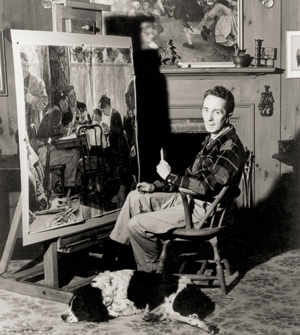
Norman Rockwell was born in New York City on February 3, 1894. His grandfather was a starving artist who immigrated from England. His father, who also liked to draw, used to read to the family at the dinner table. With his sketchbook and pencil in hand, Norman would sketch the characters that his father described in Charles Dickens' works.
As an adult, Norman dreamed of painting covers for the Saturday Evening Post, a magazine he would later call "the greatest show window in America". He submitted "Boy with Baby Carriage" in 1916 to the magazine, starting a relationship that would last 47 years and include 300-plus covers.
A look at a Norman Rockwell gallery is a look at the 20th Century history of America. It starts with "Excuse My Dust", the painter's portrayal of an early automobile in 1920. He painted "Wonders of Radio" in 1922 to highlight Marconi's invention. "Charles Lindbergh's Flight" shows the aviator's first trans-Atlantic flight in the 1930's. Next came "Rosie the Riveter", focussing on women wartime factory workers in 1943. "War Bond" helped sell war bonds to America in 1944. Another invention was illustrated in 1949 with "New TV Set". As Rockwell explained: "Without thinking about it in specific terms, I was showing the America I knew and observed to others who might not have noticed." (http://www.nrm.org/about/about-2/about-norman-rockwell/) "
The American themes continued in the 1950's. Rockwell's religious upbringing influenced his painting "Saying Grace" from 1951. "Choir Boy" from 1954 uses beautiful colours. With another child as his subject, he painted "Before the Shot", a little boy getting a needle in the doctor's office, in 1958. "The Problem We All Live With", about the integration of a young black girl into an all white school accompanied by the National Guard, focusses on Civil Rights. The following year Rockwell painted "Southern Justice: Murder in Mississippi" which I suspect is about the slaying of the three Civil Rights activists. Lastly, Rockwell's Christian faith was evident again in his piece "Uneasy Christmas in the Birthplace of Christ (Christmas Eve in Bethlehem)" from 1970.
In his long lifetime, Rockwell painted 4000 paintings. He painted every day except Christmas, when he only worked half a day. "Every painting is a new adventure," he explained, suggesting that perhaps that is why he lived such a long life. "[Artists] are always looking ahead to something new and exciting. The secret is to not look back." (http://www.encyclopedia.com/people/literature-and-arts/american-art-biographies/norman-rockwell).

Norman Rockwell in his studio with the recently painted Saying Grace courtesy
http://www.go-star.com/antiquing/famous0613.htm.
http://www.go-star.com/antiquing/famous0613.htm.
No comments:
Post a Comment